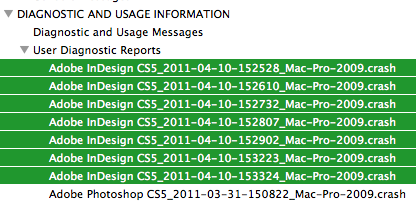Word and InDesign: Fixing import crashes
Posted by Pierre Igot in: MicrosoftApril 11th, 2011 • 9:34 am
It’s that time of the year again. I am putting together a publication for our local university in InDesign CS5, and I have to work with existing Word files that were submitted by the various contributors and then edited by the publication’s editor-in-chief.
And when you combine two lousy pieces of software such as Office 2011 and Adobe Creative Suite 5 for Mac OS X, you sure get some explosive crap.
By which I mean this:

Yes, these are my desperate attempts, yesterday afternoon, to import a particularly refractory Word document into my InDesign CS5 publication using the “Place…” command — which is, as far as I am aware, the only way to preserve style-based formatting and several key typographic elements, such as non-breaking spaces.
I already wrote about this problem last year. At the time, I wrote about a bug causing InDesign CS5 (and CS4) to fail to import some footnotes, for no apparent reason, in Word files imported using the “Place…” command (and since this is a university review, you can be sure that there are tons of footnotes to import). I wrote that I was able to work around this problem by saving the Word files as .docx files rather than .doc files.
But I also wrote that I was experiencing a number of InDesign CS5 crashes when attempting to import certain Word files, even in the .docx file format.
I thought that I had identified the source of the problem when I found that some of my Word files contained hidden field codes or bookmarks. Eliminating those seemed to alleviate the crashes.
But yesterday I had such a .docx file. I made sure that there were no bookmarks and no field codes in the file. And still InDesign CS5 would crash every time I attempted to import the file.
I was able to import the file by converting it back to the .doc format, and also to the .rtf format, both of which the “Place…” command in InDesign recognizes, but in both cases, some of the footnotes were missing. (The missing footnotes were not the same ones for the .doc version and for the .rtf version, which clearly points to a bug in InDesign itself.)
This was not a satisfactory solution. I didn’t fancy having to restore the missing footnotes manually through cut-and-paste.
Finally, out of desperation, I tried the trusted old trick of saving the .docx file as a .htm file in Word 2011, and then back as a .docx file. It’s a pretty absurd thing, but I was desperate… And guess what? It worked. After the file went through this process, I was able to place it into my InDesign publication as a .docx file, without any problems, and with no footnotes missing.
Somehow, it appears that the .docx-.htm-.docx cycle in Microsoft Word miraculously eliminates some invisible corruption that causes InDesign to crash whenever you attempt to place the original Word document in a publication.
It is utterly ridiculous. But when you use the option “Save entire file into HTML” during the process of saving the file as .htm (as opposed to the “Save only display information into HTML” option, whatever it means), Word actually preserves all your style-based formatting, and so when you reopen the file and resave it in the .docx format, everything is preserved — except for that invisible crap that causes InDesign to crash, of course.
The HTML code that Word 2011 produces is obviously beyond a joke from a web-standards point of view, but it does have the advantage of preserving all your style-based formatting.
I was able to verify this workaround with several files in succession: I went through the .docx-.htm-.docx cycle for each of them before placing them into InDesign, and I didn’t have a single crash after that.
In fact, I even noticed that the importing process itself was significantly faster in InDesign CS5. I do not know what it is that the .docx-.htm-.docx cycle erases, but it sure appears to be something that InDesign really does not like.
So, the bottom line is that this appears to be a fix that works for now. But I still find it absolutely scandalous
- that InDesign CS5 crashes so easily and so catastrophically when attempting to import certain Word files
- that InDesign CS5 still fails to import all footnotes when importing certain .doc and .rtf files, without warning and without explanation
- that one has to go through such a workaround in Word just to fix some invisible crap created by Word itself
And I cannot help but worry that, Microsoft being Microsoft, at some point in the future they will decide that they want to “improve” the Save as HTML feature and will, in the process, destroy this ability to use the .docx-.htm-.docx cycle as a workaround for so many bugs/problems with corrupted Word documents.
Since Microsoft appears unable to eliminate document corruption in the files that its software produces in the first place, this worries me a lot. But for now, it appears that the .docx-.htm-.docx cycle still works as a fix, and that it actually does help alleviate Adobe InDesign’s own crappiness, in a more effective way than the various other workarounds that I had identified last year did.
September 2nd, 2011 at Sep 02, 11 | 2:32 pm
[…] from a reader earlier this week thanking me for my posts on Adobe InDesign, and for the ones about footnotes in particular. He mentioned this bug and the discussion thread to me, and the fact that no one […]